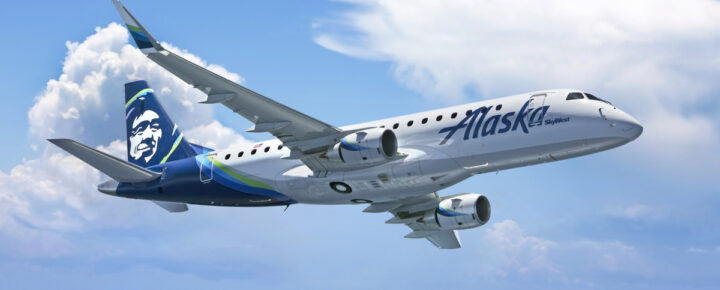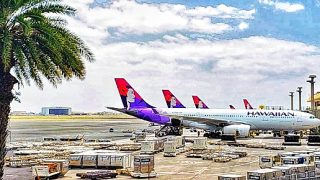With Alaska Airlines’ recent acquisition of Hawaiian Airlines, many riddles need to be solved about how this merger will reshape air travel in Hawaii. For one, how will Alaska address Hawaii’s aging interisland fleet and reshape the future of travel between the islands?
In our interview with Hawaiian CEO Joe Sprague last week, he discussed the similarities between Hawaiian interisland flying and Alaska intrastate flying, to which they have been long committed.
Hawaiian Airlines has long relied on its fleet of Boeing 717s for interisland service. This highly reliable workhorse fleet, having well exceeded its original life expectancy, is approaching an average age of 25 years. In contrast, Alaska boasts the youngest fleet of all US airlines, averaging under 10 years. It includes the larger Boeing 737 MAX series, its legacy Boeing 737’s, and the smaller Embraer E175. Both the E175 and the MAX fleets could play fascinating roles in the future of Hawaii’s interisland flights.
The aging Hawaiian Airlines 717 and the need for change are becoming apparent.
These aircraft have been the powerhouse of interisland routes, handling the high-frequency, short-haul flights essential for Hawaii visitors and residents. However, they will continue to be more costly to maintain as they age, and they lack the modern amenities and fuel efficiency that newer jets offer. With Alaska’s acquisition of Hawaiian Airlines, there’s growing speculation about how and when they’ll phase out these older jets and what aircraft might step in to maintain and improve service.


Could Alaska’s E175 be the solution?
Alaska Airlines already operates a significant fleet of 86 Embraer 175 jets, with plans for more. They currently have orders and options for 21 additional E175 jets. The E175 is known for its operational efficiency and suitability for short-haul flights, making it one of the more attractive options for interisland service. Here’s why the E175 may be worth considering:
Flexibility and efficiency: The E175 is designed for high-frequency operations, with the ability to replicate the up to 12 cycles (flights) per day demanding schedules that Hawaiian’s B717s currently manage. This makes it well-suited to the unusual demands of interisland travel.
Fuel Efficiency, comfort, and modern amenities: As a younger and more fuel-efficient aircraft compared to the 717, the E175 would reduce operational costs while offering passengers a more current and comfortable travel experience. Another big plus for passengers is that the cabin is configured in a 2×2 seat layout, meaning there are no middle seats.
Alaska’s Horizon Air 76-seat E175 jets have 12 first-class seats, 12 premium seats, and 52 main cabin seats. Onboard amenities include free entertainment, including over 1,000 movies and TV shows. First-class customers have 110-volt power at each seat.


However, challenges exist. The E175 has a lower seating capacity (76 seats) than the 717’s 128 seats. This means Alaska might need to increase the number of daily flights or adjust schedules to accommodate current demand, which could be complicated by available gate space and infrastructure limitations at Hawaii airports. On the other hand, there may be another solution to the E175 size limitation.
A Role for the 737 MAX in Hawaii’s interisland future?
Alaska Airlines is investing heavily in its 737 MAX fleet. It may eventually have hundreds of these planes, and there is some case for at least minimal utilization of these jets on some interisland routes alongside the E175s. Here’s how the 737 MAX could fit into the interisland equation:
Greater capacity: The 737 MAX 9, for example, can carry up to 178 passengers and more cargo than the E175, making it a possible solution for the busiest interisland routes, especially those between Honolulu and Maui. These planes wouldn’t be used strictly for interisland and aren’t designed for routine short-haul, rapid fire flights.
Southwest exclusively uses its mainland based MAX fleet to fly interisland between mainland flights, which is not an ideal solution.
Operational synergy: The 737 MAX is core to Alaska’s existing fleet strategy, and using them further in Hawaii could simplify maintenance, training, and operational logistics.
Even Hawaiian Airlines has already shown that larger jets like its A321neo fleet can be used effectively for some interisland routes. This means Alaska’s 737 MAX could naturally step into this role, offering a mix of aircraft sizes rather than a more traditional one-size-fits-all approach, in order to better match variable demand across Hawaii’s interisland routes.
Challenges and considerations ahead.
Transitioning Hawaiian’s fleet from the 717’s will not be a simple process. There are financial, operational, logistical, and union considerations that need to be addressed:
Financial concerns: Alaska may choose to delay the acquisition of a new fleet following the $2 billion acquisition of Hawaiian Airlines. This significant investment means Alaska could be more cautious with immediate fleet changes, especially since they recently leveraged their frequent flyer program to secure funds for the Hawaiian deal. The timing of any fleet transition will need to balance financial prudence with the operational need to modernize.
Pilot scope clauses: Any introduction of E175s for interisland routes may face restrictions related to pilot union agreements, requiring negotiations to ensure compliance with existing pilot contracts. This could be a complex and potentially lengthy process, as scope clauses often protect pilots’ rights to operate certain aircraft on specific routes.
Infrastructure and Gate Space: Increasing the number of flights with smaller aircraft like the E175 could necessitate additional gate space, which is already limited at some airports in Hawaii. However, adding some 737 MAX 9 flights could help mitigate this issue by maintaining passenger capacity with fewer total flights, thereby reducing strain on gate availability.
The path forward: A dual approach?
The best solution for Alaska may involve a combination of E175s and 737 MAX aircraft. This dual approach offers flexibility, allowing Alaska to tailor aircraft size to the demands of each route. The E175 can serve most lower-demand routes or off-peak times, while the 737 MAX 9 can handle heavier, busier interisland flights, maintaining service levels and cargo capacity. This strategy would allow Alaska to optimize operations by using the MAX 9 for a limited number of interisland stops in a manner similar to, but less reliant than the way Southwest Airlines’ currently approaches interisland with its all 737 MAX fleet.
Alaska Airlines faces a significant challenge in revitalizing Hawaii interisland travel.
But it also presents a unique and fascinating opportunity. Should Alaska choose to leverage its significant commitment to the fleets of modern E175 and 737 MAX jets, it might offer a unique, efficient, comfortable, and reliable interisland travel experience. Whatever strategy they decide on, it will not only help facilitate the elimination of the aging 717 fleet but also set the stage for an entirely new era of interisland connectivity. The coming months will reveal more about how Alaska plans to tackle this critical aspect of Hawaii travel, but one thing is clear: change is on the horizon, and it could transform the way we island-hop in the future.
How do you think Alaska Airlines will re-imagine the Hawaiian Airlines interisland fleet?







What do you think of replacing the Boeing 717 with the Airbus A220 aircraft for interisland use? Though it seems Alaska is locked into the E175 and Boeing jets. But Hawaiian does operate Airbus aircraft on their long haul routes. Thoughts?
Mahalo for all your insights on the Hawaiian Islands.
A combination of E175 for off-peak and Max 9 for peak hour traffic might work well for interisland flying. Managing that mix will pose some challenges, but at least Alaska will be bringing far better tech to the table.